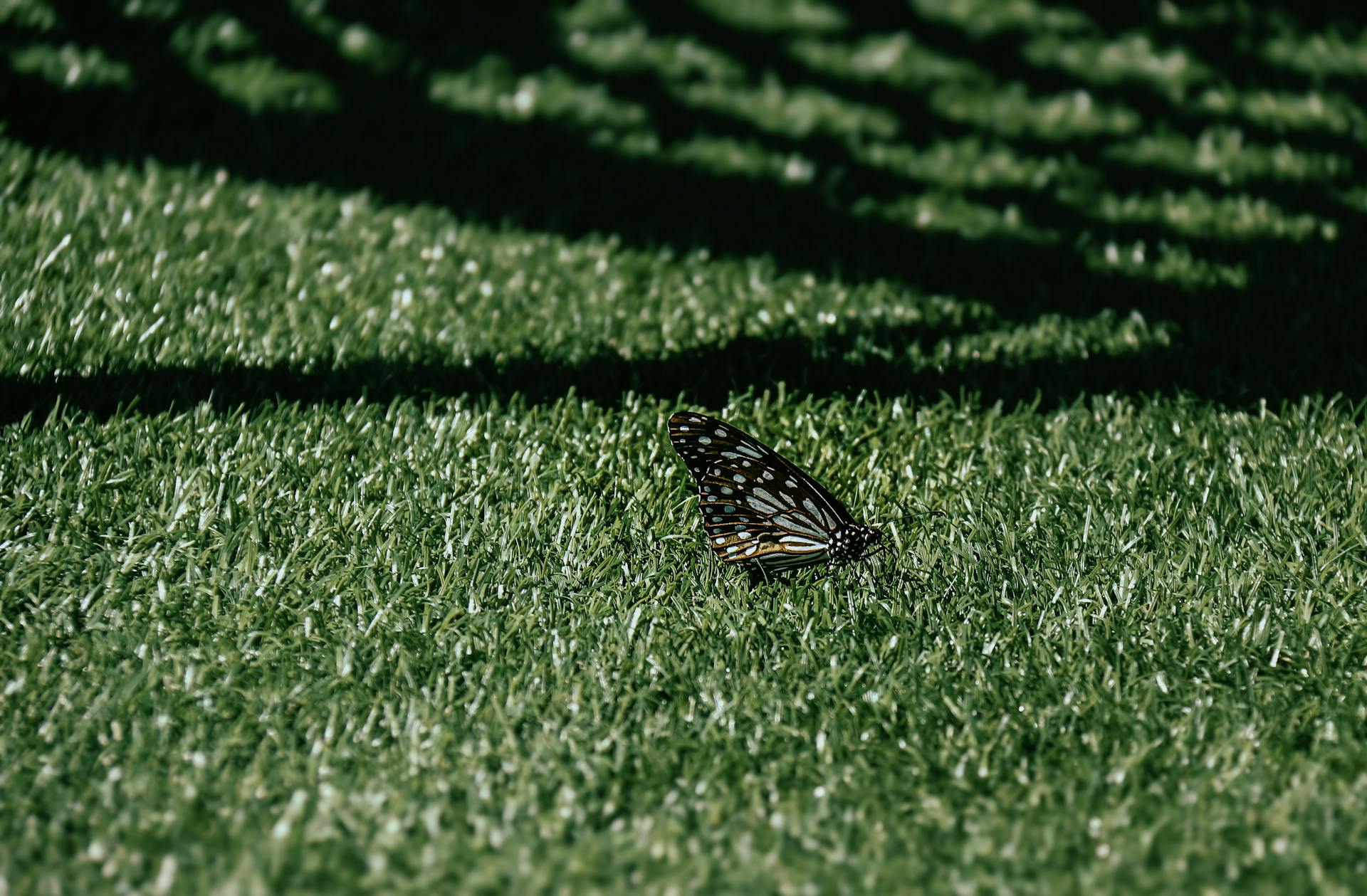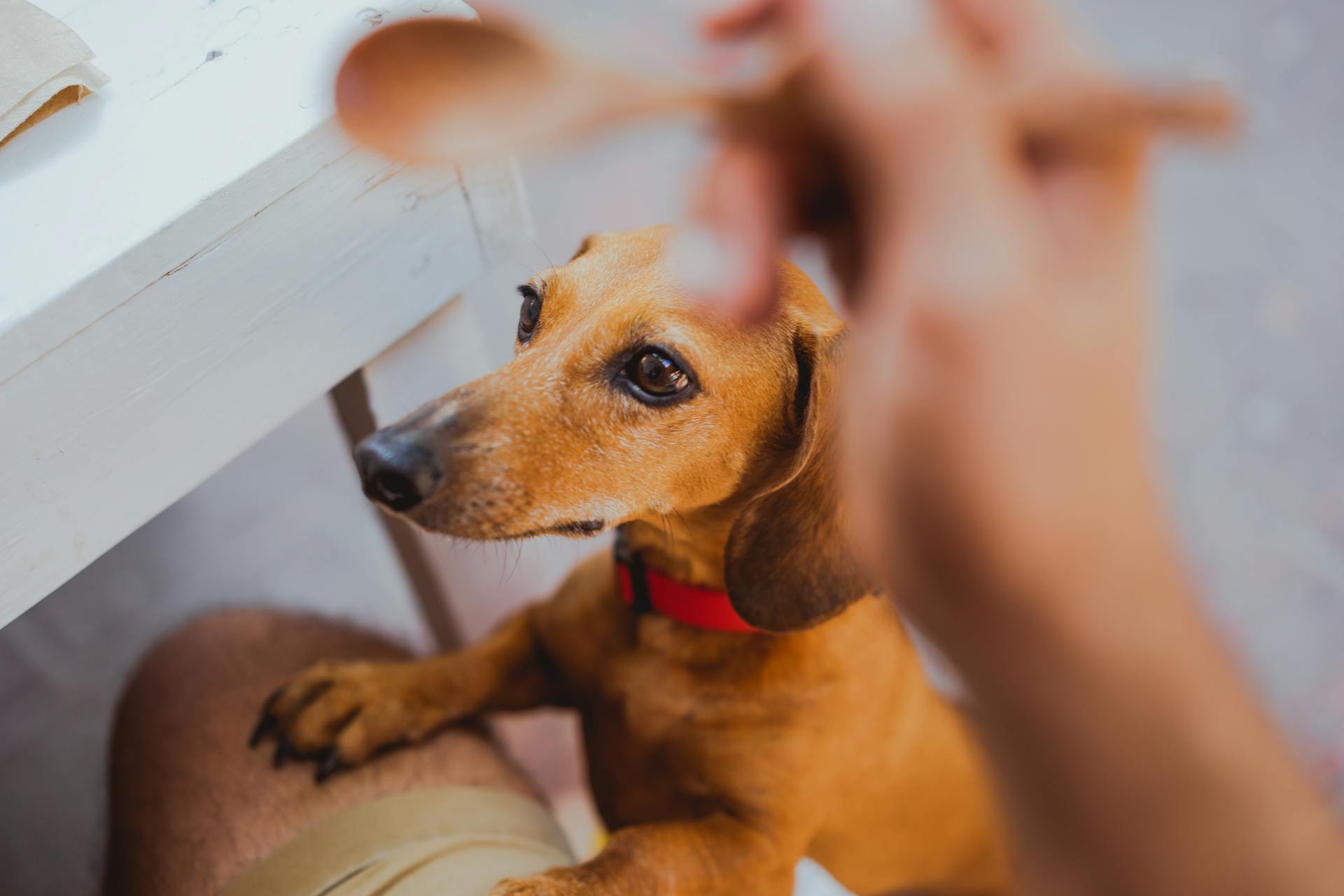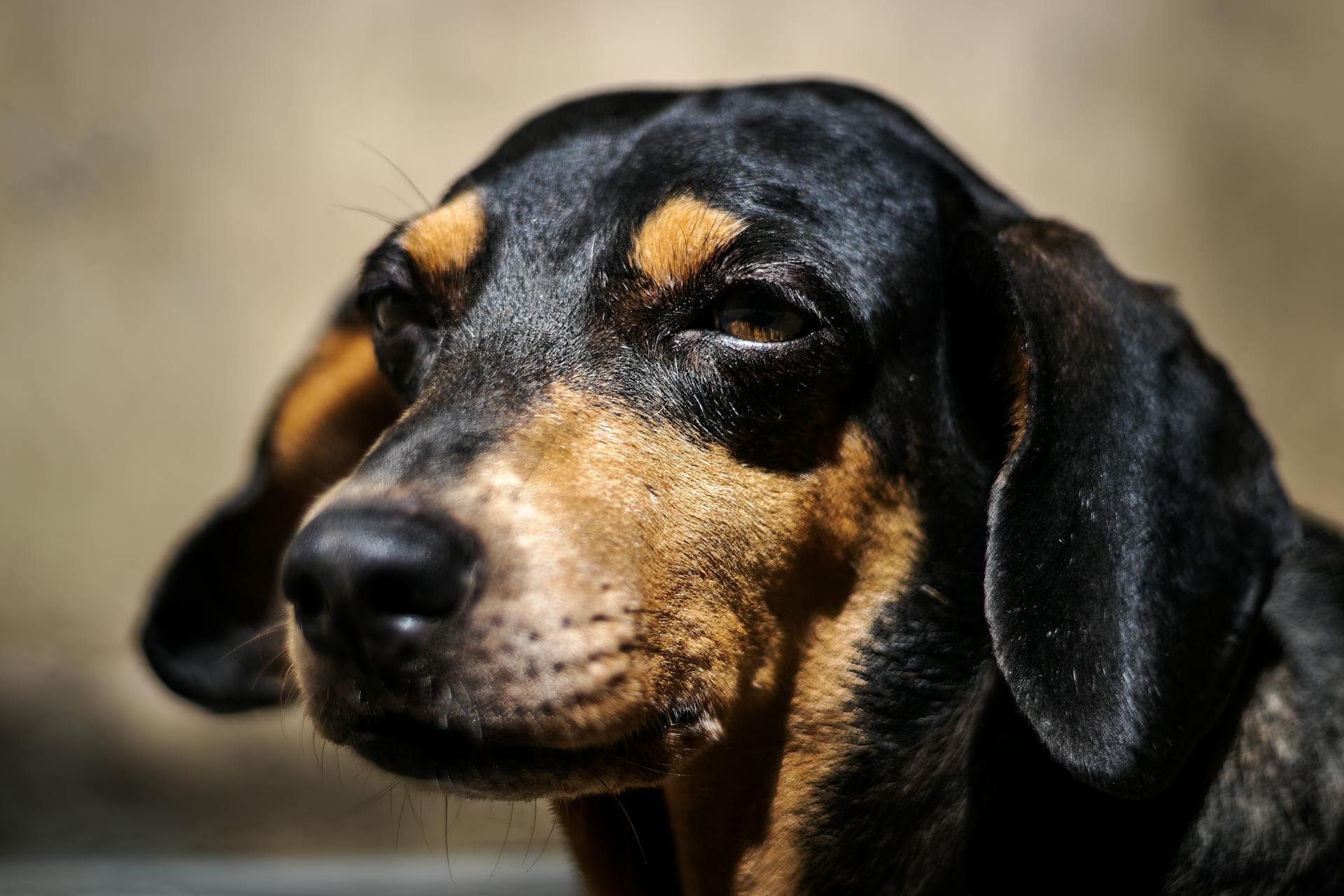
The Dapple Doxiepoo is a unique and lovable canine mix that's sure to capture your heart.
This adorable breed is a cross between a Dachshund and a Poodle, with the Dapple Doxiepoo's distinctive dapple pattern inherited from its Dachshund parent.
Their short, compact bodies are a result of their Dachshund heritage, while their low-shedding coat is a gift from their Poodle parent.
The Dapple Doxiepoo's friendly and outgoing personality makes them a great companion for families and individuals alike.
Dachshunds
Dachshunds are a key part of the Dapple Doxiepoo's heritage. They're a lively and loving breed, often described as loyal and intelligent.
Their size can vary, but on average, Dachshunds stand about 6-10 inches tall at the shoulder and weigh 16-32 pounds. This is a good starting point to understand the potential size range of your Dapple Doxiepoo.
Dachshunds are prone to certain health issues, including Intervertebral disc disease (IVDD), patellar luxation, and eye problems. Regular veterinary check-ups and a healthy lifestyle can help mitigate these risks.
You may want to research Dachshunds further to understand their potential characteristics, such as their tendency to be independent or dig. This can help you better prepare for life with a Dapple Doxiepoo.
Doxie Temperament
Dapple Doxiepoos are known for their friendly, affectionate, and playful nature, making them excellent companions for families, singles, and seniors alike.
They are intelligent and eager to please, which means they can be relatively easy to train, although they may also inherit the stubbornness and bullheadedness of their Dachshund parents.
Doxiepoos typically get along well with children and other pets, but early socialization is vital to ensure they get along with others.
Some Doxiepoos may inherit the Dachshund's hunting instincts, so keeping an eye on them around small animals and children is essential.
Most Doxiepoos are moderately energetic and enjoy regular walks and play sessions.
They tend to be big barkers and want to sound the alarm every time the doorbell rings, a squirrel runs past, and the mail is delivered.
This makes them ill-suited to apartment living, unless you're willing to take steps to address their barking.
Doxiepoos are sweet and affectionate, and they'll love spending time with their family and happily accept the role of lap dog.
They form strong bonds with their families and love being included in all family activities.
Doxiepoos can be a bit jealous with all that affection, so they do best in a single-pet home.
However, with early socialization, they can tolerate other pets and do well with children and people in general.
They can adapt to both apartments and houses with yards, provided they are allowed exercise time.
Size and Appearance
The Dapple Doxiepoo's size can vary greatly, ranging from 5 to 15 inches tall at the shoulder and weighing 6 to 30 pounds.
Their height can span from 5 to 15 inches, with some Doxiepoos being as short as 5 inches and others reaching 15 inches tall.
One of the most noticeable features of the Doxiepoo is their coat, which can range from short and smooth to curly or wavy, depending on which parent breed they take after more.
Poodle
Poodles hail from Germany, bred as hunting dogs with strong swimming abilities and waterproof coats to retrieve ducks from the water.
They're known to be one of the most intelligent and trainable dog breeds, making them a popular choice for first-time dog owners.
Their intelligence is likely to be inherited by their Doxie Poo offspring, contributing to the breed's overall trainability.
Poodles have a strong work ethic, which can sometimes make them a bit stubborn - but with the right training, they're quick learners.
A fresh viewpoint: Full Grown Dapple Dachshund
Doxie Poos Vary Greatly in Size and Appearance
Doxiepoos can weigh anywhere from 5 to 30 pounds.
Their height spans from 5 to 15 inches tall at the shoulder.
There's a wide range in size for this mixed breed.
Some Doxiepoos can inherit more Dachshund traits and have shorter legs, while others will have longer Poodle legs.
Since they don't have any official breed standards, there's really no reason for them to have a uniform appearance.
Doxiepoos can range from small to medium in size, depending on their parent breed.
Here's a rough breakdown of the different sizes and weights of Doxiepoos:
Keep in mind that these are just rough estimates, and individual Doxiepoos can vary significantly.
Coat and Grooming
The dapple Doxiepoo's coat is one of its most distinctive features, combining the curly, soft coat of a Poodle with the short, smooth coat of a Dachshund.
Their coat can be a wide variety of types, from short and wavy to long and curly, making it hard to predict what coat type they will have, even based on their parents.
Dapple Doxiepoos can have coats of more than one color, with different markings and subtle patterns like dapple, brindle, and sable.
They can include colors such as black, brown, liver, chocolate, gray, red, white, and cream.
Regular grooming is necessary to keep their coat healthy and tangle-free, and they should be brushed at least once or twice a week, depending on the length and texture of their coat.
Doxiepoos may require professional grooming every few months to keep their coat trimmed and well-maintained, with the curlier the coat, the more maintenance needed.
Pay close attention to the ears, keeping them dry and using a gentle ear cleanser or wipes once every week or so to keep the ears clean and free of debris and bacteria.
Regular teeth brushing, ear cleaning, and nail trimming are also essential for their overall health and well-being.
Dental care is especially important for small breeds, as periodontal disease is quite common.
Exercise and Living Needs
Dapple Doxiepoos need regular daily mental and physical stimulation to stay happy and healthy. They require two short walks a day, about half an hour each, to prevent boredom and destructive behaviors.
Plenty of physical exercise is necessary for maintaining a healthy weight and overall well-being. Don't let their small size fool you, these pups have a ton of energy.
Daily walks, playtime, and interactive games are excellent ways to provide exercise and mental stimulation for your Doxiepoo. In addition to engaging in dog sports, agility work, or learning tricks can offer a fun and rewarding challenge for both you and your dog.
Doxiepoos need owners who are home a lot and can give them plenty of attention, walks, and love. They can be a bit loud, so keep that in mind if you live in close quarters or have other barky dogs.
They can thrive in cities, suburbs, or rural areas, but think twice before bringing a Doxiepoo into an apartment or townhouse due to their frequent barking and potential climbing difficulties.
Doxiepoos are small dogs that don't need wide open spaces to live happily. Regular walks or backyard playtime can be sufficient for their needs.
Some Doxiepoos may be particular about their pet pals, so introductions to cats and other small animals should be done slowly, with caution and supervision.
Training and Care
Doxiepoos are quick learners and respond well to positive reinforcement methods, making them a joy to train. They thrive on consistency and patience, especially when it comes to inheriting stubbornness from their Dachshund parent.
Early socialization and reward-based training approaches are essential for developing a well-mannered pup. This includes using treats, cuddles, and toys to motivate them.
They have medium energy levels and need regular exercise, such as walks or playtime in a fenced yard, to keep them happy and stimulated. This can also help alleviate boredom and prevent destructive behavior.
Regular nail trims, ear cleanings, and dental care are necessary to maintain their overall health and well-being.
Training
Doxiepoos are quick learners and respond well to positive reinforcement methods, making them a joy to train. Consistency and patience are key, especially when it comes to developing good manners.
They're intelligent and eager to please, so they thrive on rewards like treats, cuddles, and toys. This approach works best for them, as it taps into their natural desire to please.
Short and fun training sessions are ideal for Doxiepoos, as they can get bored or distracted if sessions are too long. Breaking up training into multiple short sessions throughout the day can be very effective.
Smaller Doxiepoos may have a harder time with potty training due to their smaller bladders, requiring more frequent trips outside. However, with time and patience, they'll learn to go outside to potty and won't need to be let out as often.
Doxiepoos are highly motivated by rewards, which makes positive reinforcement training a breeze. They'll work hard to earn those treats and praise!
Care
Doxiepoos require minimal grooming, but those with wiry hair or long locks may need extra attention to prevent matting.
Regular nail trims, ear cleanings, and dental care are a must for all Doxiepoos, regardless of their coat type.
They love to exercise, so be prepared to walk your Doxiepoo or spend time playing in a fenced yard - they have medium energy levels and need time to sniff around.
Consistent positive reinforcement-based training is key, and choosing activities that challenge their intelligent side and appeal to their independent nature will keep them happy and engaged.

Puzzle toys are a great way to keep their minds stimulated and prevent boredom.
Yearly check-ups with the vet are essential to maintain their ideal health, and daily exercise is a must, but it doesn't have to be intense - a walk around the neighborhood or park will do.
They don't enjoy being outside alone, so it's best to keep them with the family as much as possible.
Walking to new places together is a great way to stimulate their minds and prevent separation anxiety.
Teeth should be cleaned at least twice a week, and ears should be cleaned with a veterinary-approved solution to avoid infections.
Nail trimming is also a must to prevent them from clicking against the floor.
An ideal Doxiepoo diet should be high in energy and formulated for a small or medium breed, depending on their size.
They can be prone to obesity, so it's essential to monitor their food portions and treat allotments carefully.
It's best to consult with your vet for specific recommendations on their diet, as their needs will change from puppyhood to adulthood and into their senior years.
Owning a Doxie Poo
Doxie Poos are generally quick learners and respond well to positive reinforcement methods.
They thrive on consistent, reward-based training approaches and can get bored if left alone too much, so daily exercise and mental stimulation are essential.
Doxie Poos are intelligent and eager to please, but some may inherit the stubbornness of their Dachshund parent, so patience and consistency are critical.
They love spending time with their family and will happily accept the role of lap dog, but they can be big barkers and may not be the best fit for apartment living.
To prevent excessive barking, it's helpful to teach a "no bark" command at an early age.
Doxie Poos require regular nail trims, ear cleanings, and routine dental care to maintain their overall health.
A yearly check-up with the vet is also important to maintain ideal health.
With proper training and care, Doxie Poos can make wonderful and loving companions for active families.
A unique perspective: Dapple Dachshund Health Problems
They're adaptable to living in small spaces, provided they get accompanied exploration outside.
Doxie Poos love walking to new places together, which stimulates their minds and helps with separation anxiety.
They're intelligent and can get bored if left alone too much, so puzzle toys and interactive games are great ways to keep them engaged.
Regular physical and mental stimulation will help your Doxie Poo burn off energy and alleviate boredom.
With some time and patience, your Doxie Poo will learn to go outside to potty and won't have to be let out as frequently when they get a little older.
Health and Nutrition
Dapple Doxiepoos can live a long and healthy life, with a lifespan of 10-18 years. They may be prone to certain health issues, but as a mixed breed, they often tend to be healthier and live longer than their parent breeds.
Their diet is crucial in maintaining their health. Dapple Doxiepoos do best on food formulated for medium and small breeds, with a mix of dry kibble and wet food being the best option. Real animal proteins and natural ingredients should be the top priority.
To prevent obesity, it's essential not to free-feed them and to provide only a few treats and small portions. Depending on their size, they will eat between one to two cups of food a day. A winter coat may also help them navigate cold or snowy winter weather.
Here are some potential health issues to look out for:
- Intervertebral disc disease (IVDD)
- Luxating patella
- Eye and vision problems
- Back injuries
- Legg-Calve-Perthes (a hip condition)
- Heart problems
- Ear infections
Nutrition
Doxiepoos do best on food formulated for medium and small breeds. Their dietary needs will change from puppyhood to adulthood and beyond, so it's essential to consult with your vet for personalized recommendations.
Stick to real animal proteins and natural ingredients in your Doxiepoo's diet. A mix of dry kibble and wet food is best, as it provides a balanced and varied nutrient intake.
Because Doxiepoos are prone to overeating, it's crucial to avoid free-feeding them. Instead, provide small portions and limit treats to keep them healthy.
To prevent obesity, be mindful of your Doxiepoo's food portions and treat allotments. Your vet can help you determine the ideal amounts for your dog's size and energy level.
Doxiepoos can tolerate any climate, but they prefer warmer temperatures. If you live in an area with cold winters, consider getting a winter coat to help your Doxiepoo navigate the weather.
Health and Conditions
Doxiepoos can live a long and healthy life, typically between 10-18 years. With proper care and attention, they can avoid or manage many potential health issues.
Their parent breeds, Dachshunds and Poodles, are prone to certain conditions that can affect their Doxiepoo offspring. These include intervertebral disc disease (IVDD), which can cause severe pain and partial paralysis, and luxating patella, a condition that makes it hard for dogs to put weight on the affected leg.
Maintaining a healthy weight and avoiding jumps on and off furniture can help minimize the risk of back injuries and IVDD. Regular exercise and a balanced diet can also support overall health.
Some common health issues that can affect Doxiepoos include hip dysplasia, patella luxation, thyroid issues, Addison's disease, and eye and vision problems. Regular eye exams can help catch any issues early and ensure good vision.
Here are some potential health issues to watch out for in your Doxiepoo:
- Intervertebral disc disease (IVDD)
- Luxating patella
- Hip dysplasia
- Patella luxation
- Thyroid issues
- Eye and vision problems
It's essential to be aware of these potential health issues and take steps to prevent or manage them. By being proactive and working with your veterinarian, you can help your Doxiepoo live a long, happy, and healthy life.
Breeders & Costs
The Dapple Doxiepoo is a unique and lovable breed, but it's essential to understand the costs involved in bringing one home. The cost for a Dapple Doxiepoo pup can vary greatly, ranging between $250 to $2,000.
Reputable breeders are crucial to finding a healthy and well-cared-for puppy. You should always ask questions about care, the parent dogs, previous litters, and what health screenings are performed.
Featured Images: pexels.com


